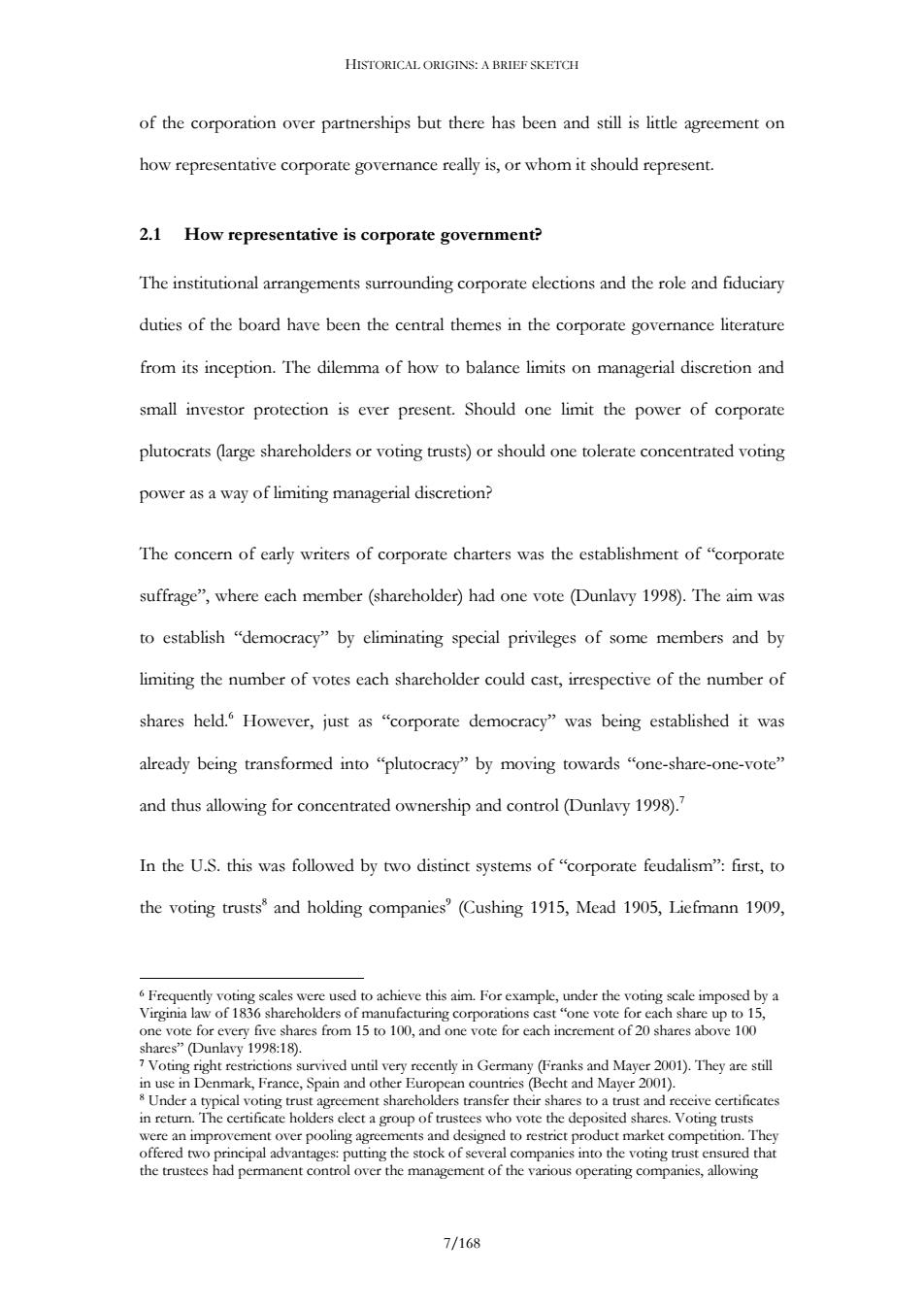正在加载图片...

HISTORICAL ORIGINS:A BRIEF SKETCH of the corporation over partnerships but there has been and still is little agreement on how representative corporate governance really is,or whom it should represent. 2.1 How representative is corporate government? The institutional arrangements surrounding corporate elections and the role and fiduciary duties of the board have been the central themes in the corporate governance literature from its inception.The dilemma of how to balance limits on managerial discretion and small investor protection is ever present.Should one limit the power of corporate plutocrats (large shareholders or voting trusts)or should one tolerate concentrated voting power as a way of limiting managerial discretion? The concern of early writers of corporate charters was the establishment of "corporate suffrage",where each member (shareholder)had one vote (Dunlavy 1998).The aim was to establish "democracy"by eliminating special privileges of some members and by limiting the number of votes each shareholder could cast,irrespective of the number of shares held.However,just as "corporate democracy"was being established it was already being transformed into "plutocracy"by moving towards "one-share-one-vote" and thus allowing for concentrated ownership and control (Dunlavy 1998). In the U.S.this was followed by two distinct systems of "corporate feudalism":first,to the voting trusts"and holding companies'(Cushing 1915,Mead 1905,Liefmann 1909, 6 Frequently voting scales were used to achieve this aim.For example,under the voting scale imposed by a Virginia law of 1836 shareholders of manufacturing corporations cast"one vote for each share up to 15, one vote for every five shares from 15 to 100,and one vote for each increment of 20 shares above 100 shares"(Dunlavy 1998:18). 7 Voting right restrictions survived until very recently in Germany (Franks and Mayer 2001).They are still in use in Denmark,France,Spain and other European countries(Becht and Mayer 2001). Under a typical voting trust agreement shareholders transfer their shares to a trust and receive certificates in return.The certificate holders elect a group of trustees who vote the deposited shares.Voting trusts were an improvement over pooling agreements and designed to restrict product market competition.They offered two principal advantages:putting the stock of several companies into the voting trust ensured that the trustees had permanent control over the management of the various operating companies,allowing 7/168HISTORICAL ORIGINS: A BRIEF SKETCH of the corporation over partnerships but there has been and still is little agreement on how representative corporate governance really is, or whom it should represent. 2.1 How representative is corporate government? The institutional arrangements surrounding corporate elections and the role and fiduciary duties of the board have been the central themes in the corporate governance literature from its inception. The dilemma of how to balance limits on managerial discretion and small investor protection is ever present. Should one limit the power of corporate plutocrats (large shareholders or voting trusts) or should one tolerate concentrated voting power as a way of limiting managerial discretion? The concern of early writers of corporate charters was the establishment of “corporate suffrage”, where each member (shareholder) had one vote (Dunlavy 1998). The aim was to establish “democracy” by eliminating special privileges of some members and by limiting the number of votes each shareholder could cast, irrespective of the number of shares held.6 However, just as “corporate democracy” was being established it was already being transformed into “plutocracy” by moving towards “one-share-one-vote” and thus allowing for concentrated ownership and control (Dunlavy 1998).7 In the U.S. this was followed by two distinct systems of “corporate feudalism”: first, to the voting trusts8 and holding companies9 (Cushing 1915, Mead 1905, Liefmann 1909, 6 Frequently voting scales were used to achieve this aim. For example, under the voting scale imposed by a Virginia law of 1836 shareholders of manufacturing corporations cast “one vote for each share up to 15, one vote for every five shares from 15 to 100, and one vote for each increment of 20 shares above 100 shares” (Dunlavy 1998:18). 7 Voting right restrictions survived until very recently in Germany (Franks and Mayer 2001). They are still in use in Denmark, France, Spain and other European countries (Becht and Mayer 2001). 8 Under a typical voting trust agreement shareholders transfer their shares to a trust and receive certificates in return. The certificate holders elect a group of trustees who vote the deposited shares. Voting trusts were an improvement over pooling agreements and designed to restrict product market competition. They offered two principal advantages: putting the stock of several companies into the voting trust ensured that the trustees had permanent control over the management of the various operating companies, allowing 7/168